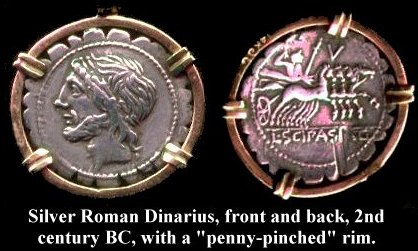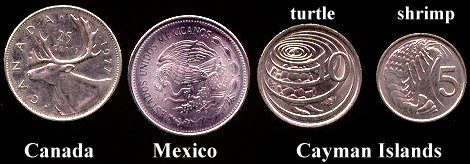Numismatics
Today, let's read what's written on coins. The University of Houston's College of Engineering presents this series about the machines that make our civilization run, and the people whose ingenuity created them.
Coin collectors call their work numismatics -- the science of coins. That sounds a bit grand, but think for a minute about coins. They're the most durable written record. They reflect the myths and legends of a people. They tell us what people honored -- what they found beautiful.
American coins once showed us buffalo, Indians, and Miss Liberty. They still show bald eagles. They've always honored great presidents. We've recently begun celebrating America with scenes from each of the states.

And all our coins affirm a trust in God, variable though that conviction may be.
Coinage is an odd technology, since coins are two things at once -- a historical record and a claim to goods and services. Since the metal in them has value, that claim endures. Bronze coins minted by the first-century Roman Emperor Domitian were still being used in Spain as late as the seventeenth century. Philip IV finally called them in and had them restamped.
Here's a late second-century-BC Roman denarius with Jupiter's picture on the front.

On the back is a Roman war chariot, called a quadriga. The rim is chipped all the way around. That's from the old way of making coins. First you stamped a silver blank. Then you nipped fragments out of the unstamped rim until the coin had the right weight. That finicky little silver-saving process also showed that the coin was solid, not just silver-plated. That's where the expression "penny-pinching" comes from.
A century later, the new gods, the Imperial Caesars, replaced the old household deities on the front of the denarius. The republic was now an empire. Only the war chariot lingered. And nineteenth-century poet Henry Dobson, looking at these old coins, said:
All passes, Art alone
Enduring stays to us;
The Bust outlasts the throne, --
The Coin, Tiberius.
Here's a handful of contemporary Cayman Island coins. What do Caymanians think about? Well, they claim membership in the British Commonwealth, so we see Queen Elizabeth on their coins. But on the other side: boats, birds, shrimp, and the Caymanian national symbol -- the turtle. A thousand years from now, these coins will still be revealing the islands as Caymanians see them today.
Money, after all, represents the works of our hands. Our interest in money has a component far more honorable than greed. Money represents what we do. And what we do is what we are.
A curious Biblical remark says that our heart will be where our treasure is. That sounds cynical at first, but then we see money as a kind of condensed representation of ourselves. Money represents our goods, our services, our daily sweat and struggle. In the end, it's not surprising that we reveal our hearts in what well might be the most personal of all our art.
I'm John Lienhard, at the University of Houston, where we're interested in the way inventive minds work.
(Theme music)
Porteous, J. Coins. London: Octopus Books Ltd., 1964.
This is a revised version of Episode 163.
